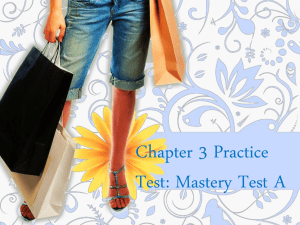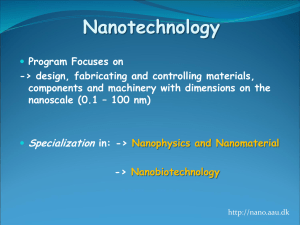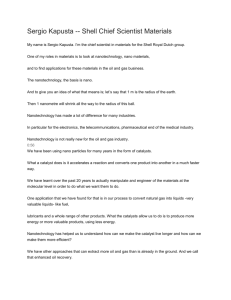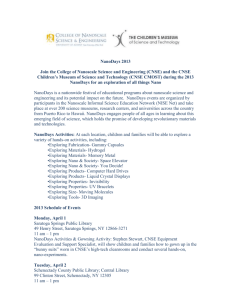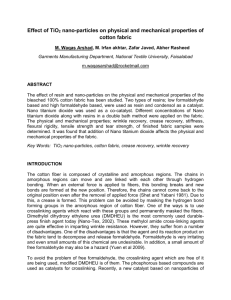Exploring Products Nano Fabric
advertisement
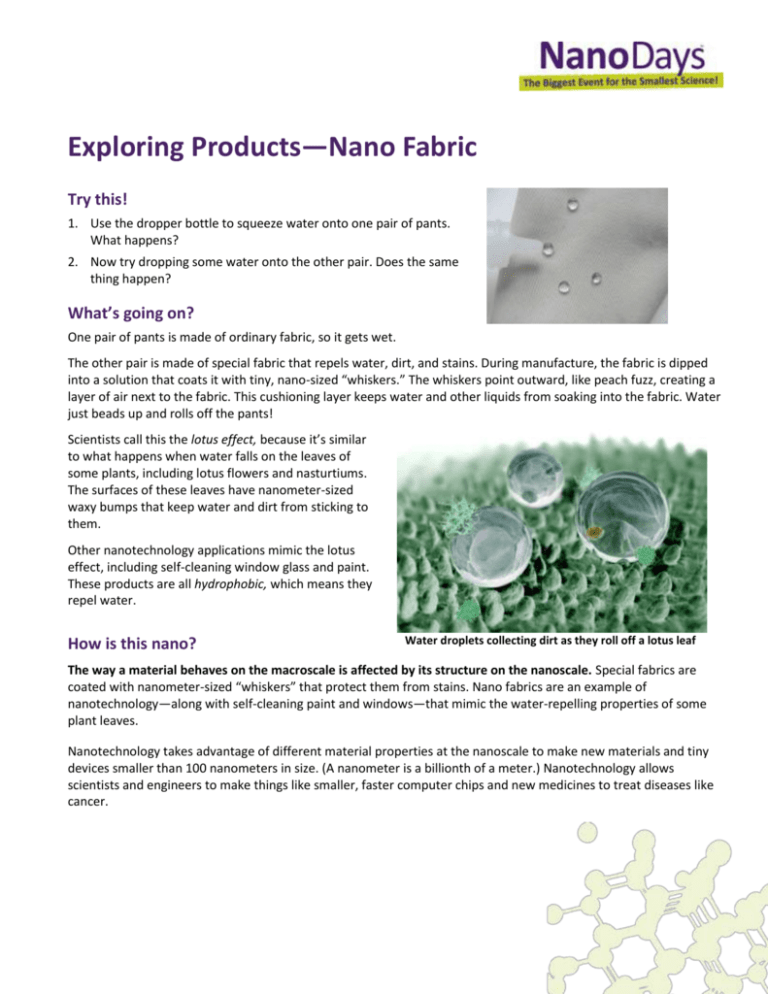
Exploring Products—Nano Fabric Try this! 1. Use the dropper bottle to squeeze water onto one pair of pants. What happens? 2. Now try dropping some water onto the other pair. Does the same thing happen? What’s going on? One pair of pants is made of ordinary fabric, so it gets wet. The other pair is made of special fabric that repels water, dirt, and stains. During manufacture, the fabric is dipped into a solution that coats it with tiny, nano-sized “whiskers.” The whiskers point outward, like peach fuzz, creating a layer of air next to the fabric. This cushioning layer keeps water and other liquids from soaking into the fabric. Water just beads up and rolls off the pants! Scientists call this the lotus effect, because it’s similar to what happens when water falls on the leaves of some plants, including lotus flowers and nasturtiums. The surfaces of these leaves have nanometer-sized waxy bumps that keep water and dirt from sticking to them. Other nanotechnology applications mimic the lotus effect, including self-cleaning window glass and paint. These products are all hydrophobic, which means they repel water. How is this nano? Water droplets collecting dirt as they roll off a lotus leaf The way a material behaves on the macroscale is affected by its structure on the nanoscale. Special fabrics are coated with nanometer-sized “whiskers” that protect them from stains. Nano fabrics are an example of nanotechnology—along with self-cleaning paint and windows—that mimic the water-repelling properties of some plant leaves. Nanotechnology takes advantage of different material properties at the nanoscale to make new materials and tiny devices smaller than 100 nanometers in size. (A nanometer is a billionth of a meter.) Nanotechnology allows scientists and engineers to make things like smaller, faster computer chips and new medicines to treat diseases like cancer. Learning objectives 1. The way a material behaves on the macroscale is affected by its structure on the nanoscale. 2. Special fabrics are coated with nanometer-sized “whiskers” that protect them from stains. Materials Pants made of nanotechnology stain-resistant fabric Pants made of ordinary fabric Dropper bottle Tray To locate pants made of nano fabric, you can search online for “stain resistant pants,” then check for the word “nano” in the garment description. Note to the presenter Before beginning this activity, fill the dropper bottle with water. Extension Visitors can compare how water behaves when dropped onto regular iceberg lettuce and onto hydrophobic plant leaves. Hydrophobic plants include lotus leaves, nasturtium leaves, mustard greens, leafy kale, broccoli, and Chinese cabbage. Related educational resources The NISE Network website (www.nisenet.org) contains additional resources to introduce visitors to nanomaterials and consumer products enabled by nanotechnology: Public programs include Aerogel, Future of Computing, Ink Jet Printer, Magic Sand, Nanoparticle Stained Glass, and Nanosilver: Breakthrough or Biohazard? NanoDays activities include Exploring Materials—Ferrofluid, Exploring Materials—Liquid Crystals, Exploring Materials—Thin Films, Exploring Products—Nano Sand, and Exploring Products—Sunblock. Media include Everything is Made of Atoms, Zoom into a Computer Chip poster, and Multimedia Zoom into a Nasturtium Leaf. Exhibits include Bump and Roll, Changing Colors, and Unexpected Properties. Credits and rights This activity was adapted from “Nano-Tex: Testing New Nano Fabrics” developed by the National Science Foundation-supported Internships in Public Science Education (IPSE) Program at the Materials Research Science and Engineering Center (MRSEC) on Nanostructured Materials and Interfaces at the University of Wisconsin-Madison. The original activity is available at mrsec.wisc.edu/Edetc/IPSE/educators/activities/nanoTex.html Fabric for the miniature pants included in the NanoDays kits courtesy of Nano-Tex, Inc. Computer-generated image of lotus effect courtesy William Thielicke, wthielicke.gmxhome.de/bionik This project was supported by the National Science Foundation under Award No. ESI-0532536. Any opinions, findings, and conclusions or recommendations expressed in this program are those of the author and do not necessarily reflect the views of the Foundation. Copyright 2010, Sciencenter, Ithaca, NY. Published under a Creative Commons Attribution-NoncommercialShareAlike license: http://creativecommons.org/licenses/by-nc-sa/3.0/us/




